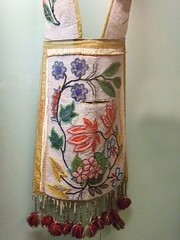
About 1675 the European traders brought colorful glass beads to the tribes. The earliest beads brought by the white people were called pony beads by the Indians because they were brought in by the traders pony pack trains. Most of these beads were dark blue. Some were white and a few were a dull red color. The Indians worked them into several rows of blue, then a few rows of white and again the blues. This type of pony beadwork continued until about 1840, when a smaller seed bead was brought in. The Indians still use seed beads.
Originally these beads were not very plentiful. For this reason Indian women use a combination of both quills and beads. After beads became plentiful, the Indians did less of the beautiful quillwork, using it often as an edging for sleeve bands, and legging strips, which were embroidered with broad bead bands. Moccasins, too, carried this combination, but the entire top of the foot would be done in quills, with the narrow band around the foot beaded. These bead strips, or bands, were usually not more than eight beads wide.
THREE TYPES OF BEADWORK USED
For some years after beads were introduced to the Indians, sinew was used in place of needles and thread for beadwork. Sinew is a tendon, or cord. The Indians generally used the long sinew found along the backbone of buffalo, deer or elk.
After the sinew had dried, it was split into very fine threadlike strands. Next, it was soaked to make it pliable. Then, twisting one end to make a point, the Indian woman strung a few beads on it. With a fine awl, she made a hole in the skin she was working on, pushed the sinew through, and pulled the beads up tight. So well did she do her work that not a stitch could be seen on the reverse side of the skin. She did this by splitting the thickness of the hide with the awl.
Overlay, or Spot Stitch
One of the earliest methods of applying the beads is called the overlay, or spot stitch. By using this method, the Indian woman could curve her design, making it into either flowers or leaves or a combination of both.
Lazy Stitch
This type of beadwork was most often used by Western Indians. It lends itself to straight-sided, or geometric, designs, and is most often seen on fully beaded vests and pipe bags and on the tops of women’s dresses.
After the Indians began to obtain cloth from the traders, they also were able to get fine bead needles, and much of the beadwork, especially that of the woodland tribes, was done on cloth.
Loom Weaving
The earliest bead loom, use by the Ojibway women, was a bow-shaped ash branch. To each upturned end they fastened a doubled-over piece of birch bark. Through a row of holes made in these pieces they threaded the loom.
When they worked with sinew, they wove so that as the thread passed through the beads one strand passed over the loom string, the next passed under, and so on. When they used thread and needle, they strung the beads on the thread and then placed the strand under the loom threads, pushing the beads up between the strands. Next they passed the needle back through the beads, taking care this time that the needle passed across the loom strings on their upper side. The beads were then drawn up tight, and the next row was added.
This bow-type loom was easy for an Indian woman to carry with her, but at home she often used a frameliked loom. This was simply four flat pieces of wood lashed together at the corner with wet sinew. As the sinew dried, it held to corners firmly together. In stringing this type of loom, she wrapped the thread around and across the frame from top to bottom. Starting the beadwork near the top of the frame, she worked downward. When she reached the lower end, she gently slid the beadwork over the top.
Native American Beadwork




0 komentar
Post a Comment